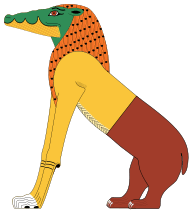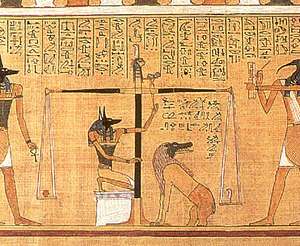Ammit
| Ammit in hieroglyphs | |||||||
|---|---|---|---|---|---|---|---|
|
ꜥm-mwt devourer of the dead | |||||||
 | |||||||

Ammit (/ˈæmɪt/; Ancient Egyptian: ꜥm-mwt, "devourer of the dead";[1] also rendered Ammut or Ahemait) was a demoness and goddess in ancient Egyptian religion with a body that was part lion, hippopotamus and crocodile—the three largest "man-eating" animals known to ancient Egyptians. A funerary deity, her titles included "Devourer of the Dead", "Eater of Hearts", and "Great of Death".[3] Ammit lived near the scales of justice in Duat, the Egyptian underworld. In the Hall of Two Truths, Anubis weighed the heart of a person against the feather of Ma'at, the goddess of truth, which was depicted as an ostrich feather (the feather was often pictured in Ma'at's headdress). If the heart was judged to be not pure, Ammit would devour it, and the person undergoing judgement was not allowed to continue their voyage towards Osiris and immortality. Once Ammit swallowed the heart, the soul was believed to become restless forever; this was called "to die a second time". Ammit was also sometimes said to stand by a lake of fire. In some traditions, the unworthy hearts were cast into the fiery lake to be destroyed. Some scholars believe Ammit and the lake represent the same concept of destruction.
Ammit was not worshipped; instead she embodied all that the Egyptians feared, threatening to bind them to eternal restlessness if they did not follow the principle of Ma'at.
Influence on popular culture
- Ammut appears (using the 'u' version of the name) as a recurring character in the cartoon Mummies Alive!. The evil ancient Egyptian wizard Scarab summons Set and Anubis in episode 3, and Ammut tagged along. He remains behind to be a general annoyance to Scarab and his familiar Heka. Ammut generally acts like a dog on the show, despite being part feline.
- Ammit was made male as a character in the Palladium RPG. A monster of the same name is also a card in Yu-Gi-Oh!
- In addition, Ammit also intermittently appears in The Kane Chronicles, a trilogy based on Egyptian Myths. In the book series, Ammit follows suit as the original myths, being the servant and companion of Anubis. Ammit is portrayed as tiny, about the size of a dog.
- Ammit is also featured in the Lara Croft and the Temple of Osiris video game.
- Ammit Cryearth is a Grimoire in form of a hand mirror that reflects the true form of the holder; it appears in BlazBlue: Remix Heart manga.
- The Magic: The Gathering set Amonkhet, which is based on ancient Egyptian life and mythology, features the card Baleful Ammit, as well as an Ammit creature mentioned twice in its official lore. Ammit also appeared in the following set "Hour of Devastation" in the card Ammit Eternal.[4]
- One of the Titans, monsters summoned from magic amulets in the animated series, Huntik: Secrets & Seekers, is a large crocodile called Ammit Heart-Eater.
- The extinct crocodile Pristichampus in the season 3 premiere of Primeval is said to be the inspiration for the story of Ammit (called Ammut in the show) after going through the anomaly.
- In the 2017 video game Assassin's Creed: Origins, the main protagonist, Bayek, experiences a hallucination in which his heart is weighed in the Duat and Ammit, portrayed inaccurately as a gigantic serpent, swallows his heart, and in the sequence then Bayek must battle Ammit to retrieve his heart.
- Ammit also appears in The Tombquest series book 5:The final kingdom.
See also
References
- 1 2 Erman, Adolf; Grapow, Hermann (1926-1961) Wörterbuch der ägyptischen Sprache, Berlin: Akademie-Verlag, volume 1, page 184.9
- ↑ "Egyptian Book of the Dead". Egyptartsite.com. Retrieved 2012-08-18.
- ↑ Hart, George (2005). The Routledge Dictionary of Egyptian Gods and Goddesses, Second Edition. Routledge. ISBN 978-0-203-02362-4.
- ↑ "Amonkhet Story". Retrieved 5 June 2017.
![]()